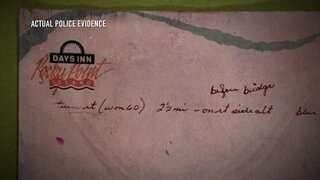Create a free profile to get unlimited access to exclusive videos, breaking news, sweepstakes, and more!
Handwritten Note Helps Investigators Discover Who Massacred Family Vacationing In Florida
Driving directions and a witness sketch helped Florida investigators find the the man who murdered Joan Rogers and her two teenage daughters.
On the morning of June 4, 1989, the bodies of three women were found floating in Tampa Bay, Florida. Each had yellow polypropylene rope tied around their necks.
“The other end of that rope was tied to a concrete block,” Cindy Leedy, a retired detective with S. Petersburg PD, told Oxygen's “Family Massacre."
The victims’ hands, feet, and mouths were bound with duct tape. They were nude from the waist down. Autopsies indicated that the cause of death was asphyxiation, either from drowning or the ropes around their necks. The medical examiner determined they’d been in the water between 50 and 60 hours, and because of that there was no evidence to determine if the victims had been raped, investigators said.
The victims' fingerprints didn’t match any in police records, but four days after the bodies were found, a Days Inn housekeeper who’d read about the murders reported that she knew hotel guests who had never returned to their room.
The tip led detectives to identify the victims: Joan Rogers, 36, and her daughters, Michelle, 17, and Christe, 14. They were vacationing in Florida while Hal Rogers, Joan’s husband and the girls’ father, stayed home to tend to their dairy farm in Wilshire, Ohio.
On June 8, Tampa police located the Rogers' car in the parking lot of a boat ramp about two miles from their hotel. A tourist brochure and a slip of Days Inn paper with handwritten notes on them were collected as evidence. The notes were directions to the boat ramp where the car was found and included a reference to a blue and white boat.
Analyzing the handwriting became one focus of the investigation. Interviewing Hal Rogers was another.
The grieving family man cooperated every step of the way with police. He explained his loved ones took a needed getaway. Michelle had allegedly been sexually abused by his brother, John Rogers, who was convicted of raping an Ohio woman. John was in prison for that crime at the time of the murders, although Michelle had declined to press charges because her uncle had threatened to kill her if she ever told anyone about him.
Had the uncle hired a hit from behind bars? The lead was investigated and eliminated. Hal Rogers was also cleared from suspicion early into the investigation.
Detectives released information about the blue and white boat in hopes that it would turn up leads. Tips poured in but none panned out.
By October 1989, Tampa police still didn’t have a suspect. But then, one of the detectives on the case learned of a reported rape in nearby Madeira Beach that occurred on May 15, just two weeks before the Rogers murders.
A tourist from Canada had gotten on a blue and white boat with a man who invited her to take a sunset cruise. He asked for sex and when she refused, he raped her. He threatened to tape her mouth and toss her into the water if she didn’t cooperate. The man had told her he owned an aluminum business and lived two hours from Madeira Beach by boat. A composite sketch of the alleged rapist was made based on the victim’s account.
The police sketch was released to the public but failed to result in viable leads. After a year, the case was in jeopardy of going cold. Investigators continued to pursue the handwriting lead as well as aluminum-related businesses in Florida. But by February 1992, two and a half years after the murders, a newly installed police chief was ready to pull the plug on the case. He gave detectives six more months.
Investigators redoubled their efforts. Billboards with pictures of the Rogers were erected in May 1992 near where the crime had actually occurred. At the same time Glen Moore, retired sergeant with the St. Petersburg PD, publicized the handwriting on the brochure through the media.
“I stuck my neck out a lot when I said, ‘If you find the person who wrote this handwriting, you’ll find the killer,” explained Moore.
On July 30, 1992, the handwriting on the brochure was shared on Tampa billboards. The next day, investigators got a call from a local woman who said she’d contacted police when the handwriting sample appeared in the newspaper six weeks earlier.
“At that time, she faxed over to us a copy of a contract which she believed matched what we published in the newspaper,” said Leedy.
The contract was written by a man who installed aluminum enclosures. His name: Oba Chandler. Detectives discovered he had owned a blue and white boat that he sold shortly after the murders. A handwriting expert matched Chandler’s handwriting with the writing on the evidence. Investigators also found that Chandler had 18 arrests as a juvenile, along with felony arrests as an adult for rape, robbery, kidnapping, and robbery. Plus, Chandler was a strong match to the composite sketch.
Police moved to arrest Chandler, who was married and had a young daughter, but found that he’d left town. Authorities tracked him down at a gas station as he was returning to Florida. He was charged for the rape of the Canadian tourist, and detectives worked to build a case that would enable them to arrest Chandler for the Rogers murders.
Chandler’s phone records, which placed him out on the water on the night of the murder, along with other evidence, convinced the D.A. to press murders.
At trial, Chandler took the stand. He admitted to writing on the brochure. He said he gave directions and that’s where his involvement began and ended. He claimed he was on the water near the crime scene because he’d had an issue with his boat’s gas line.
In the end, the jury found Chandler guilty on the three counts of murder. On November 15, 2011, Chandler, 65, who’d always maintained his innocence, died by lethal injection at a Florida correctional facility.
For more on the case and others like it, watch “Family Massacre,” streaming now on Oxygen.com.


































